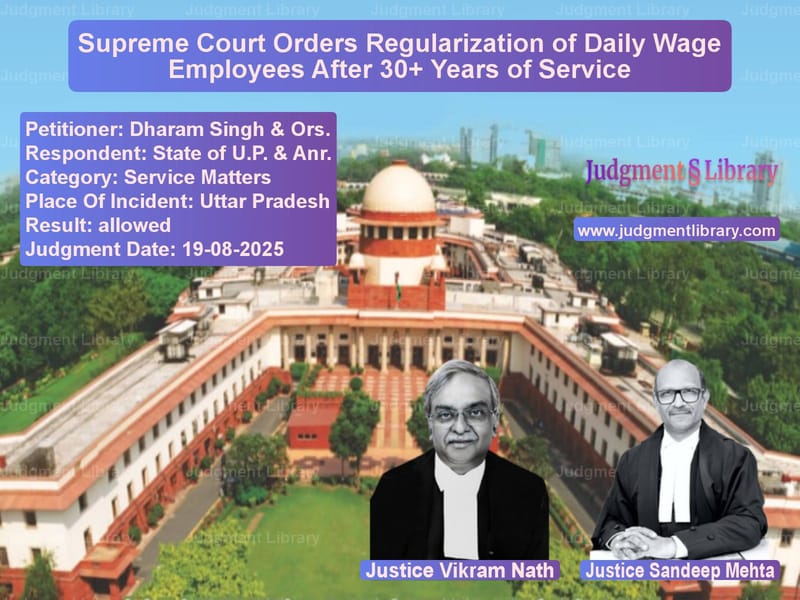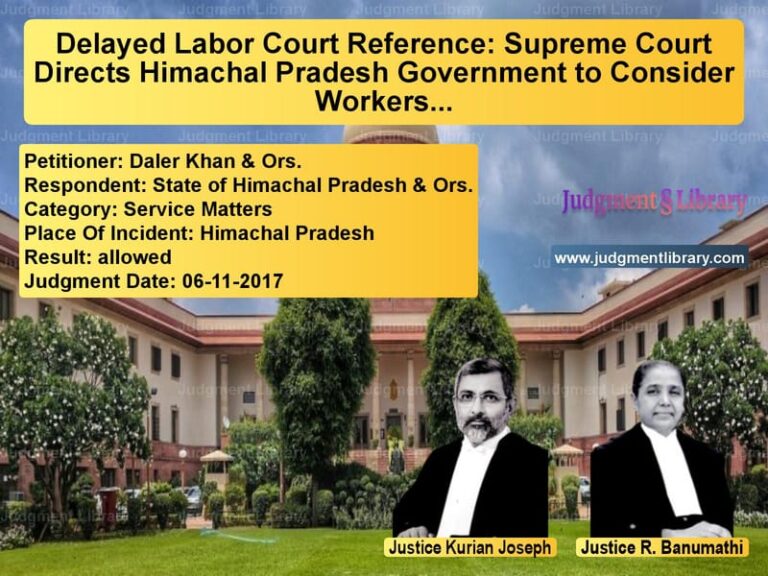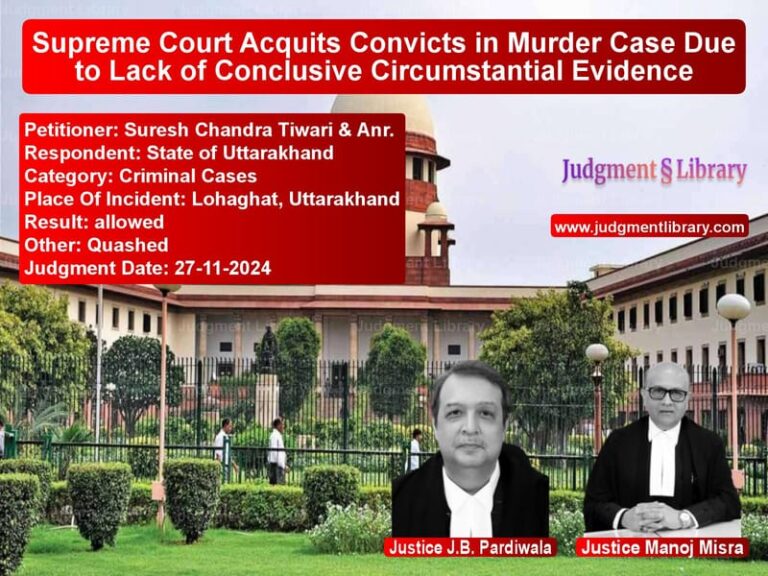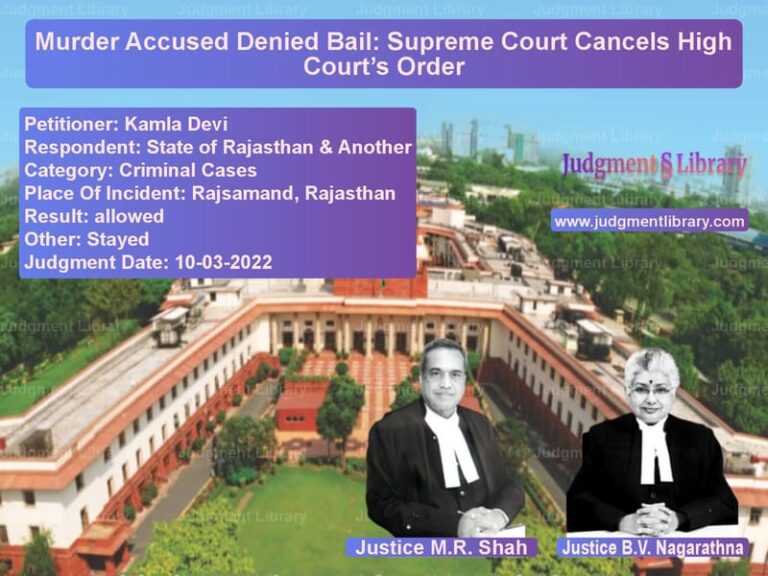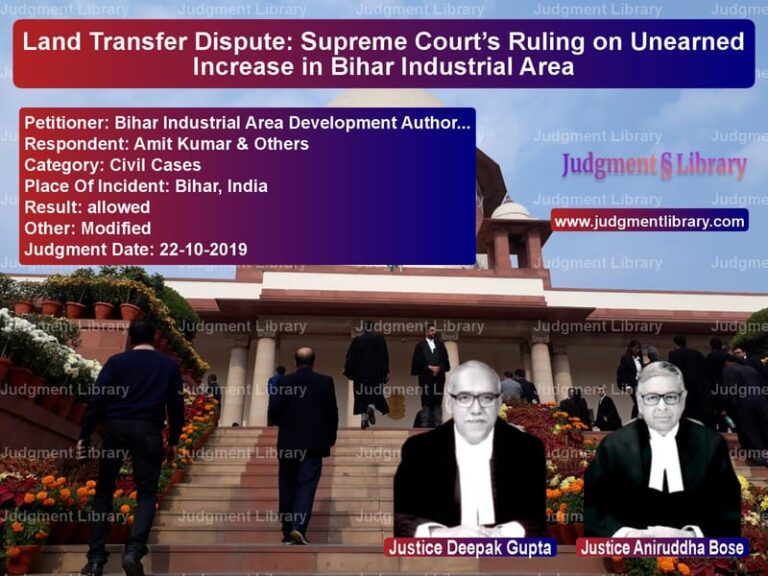Supreme Court Orders Regularization of Daily Wage Employees After 30+ Years of Service
In a powerful judgment that reaffirms the dignity of labor and the constitutional obligations of the State as an employer, the Supreme Court has delivered justice to six daily wage employees who had been working for over three decades without regularization. The case represents a significant milestone in the ongoing struggle against what the Court termed ‘ad-hocism’ – the practice of keeping workers in perpetual temporary status while extracting permanent labor from them. The judgment serves as a stark reminder that financial constraints cannot be used as a blanket excuse to deny workers their fundamental rights and that the State must organize its workforce with fairness, transparency, and respect for human dignity.
The Human Story Behind the Legal Battle
The six appellants in this case were engaged by the U.P. Higher Education Services Commission between 1989 and 1992. Five of them served as Class-IV employees performing peon and attendant duties, while the sixth worked as a Driver. For over three decades, these workers performed essential ministerial and support functions during regular office hours – sorting and scrutinizing applications, handling dispatch operations, and providing driving services – all critical to the Commission’s functioning as a recruiting body for teachers and principals. Despite performing these permanent duties, they were paid as daily wagers, receiving consolidated monthly amounts of ₹1,500 for Class-IV employees and ₹2,000 for the Driver, far below what regular employees would earn for the same work.
The Long Road Through the Legal System
The legal journey began in 2000 when the employees filed a writ petition before the Allahabad High Court after the State government repeatedly rejected the Commission’s proposals to create sanctioned posts for them. The Commission itself had recognized the need for these positions as early as 1991 when it resolved to create fourteen posts in Class-III and Class-IV categories and sought sanction from the State government. Despite repeated requests and clear acknowledgment of administrative exigencies, the State refused to sanction the posts, citing “financial constraints” and a “ban on creation of new posts.” The High Court, both at the single judge and division bench levels, dismissed their petitions, treating the matter as a mere plea for regularization and relying heavily on the famous Umadevi case precedent. The courts below concluded that since there were no specific rules for regularization in the Commission and no vacancies existed, the employees had no legal claim.
The Supreme Court’s Groundbreaking Analysis
The Supreme Court, in a judgment authored by Justice Vikram Nath with Justice Sandeep Mehta concurring, fundamentally disagreed with the High Court’s approach. The Court made it clear that this was not merely a case about regularization but about challenging the State’s arbitrary refusal to sanction posts despite clear evidence of perennial need and decades of continuous service. The Court observed that “the original writ petition before the High Court expressly assailed the State’s refusal dated 11.11.1999 to sanction posts for the Commission and sought a mandamus for creation of posts with consequential consideration for the appellants. The Single Judge of the High Court, and the Division Bench of the High Court in appeal, treated the matter as a bare plea for regularisation, answered it only on the touchstone of absence of rules and vacancy, and rested principally on Umadevi (Supra). In doing so, the Courts below failed to adjudicate the principal challenge to the State’s refusal and the legality of its reasons. In our opinion, such non-consideration amounts to a misdirection and, in effect, a failure to exercise jurisdiction.”
Rejecting the Financial Constraints Argument
The Court thoroughly examined the State’s justification of “financial constraints” and found it wanting. The judgment noted that “a non-speaking rejection on a generic plea of ‘financial constraints’, ignoring functional necessity and the employer’s own long-standing reliance on daily wagers to discharge regular duties, does not meet the standard of reasonableness expected of a model public institution.” The Court emphasized that while creation of posts is primarily an executive function, the refusal to sanction posts cannot be immune from judicial scrutiny for arbitrariness, especially when it leads to exploitation of workers over decades.
Clarifying the Umadevi Precedent
In what may be one of the most significant aspects of this judgment, the Court clarified that the reliance placed by the High Court on the Umadevi case was completely misplaced. The Court explained that “Unlike Umadevi (Supra), the challenge before us is not an invitation to bypass the constitutional scheme of public employment. It is a challenge to the State’s arbitrary refusals to sanction posts despite the employer’s own acknowledgement of need and decades of continuous reliance on the very workforce.” The Court further noted that “Umadevi (Supra) draws a distinction between illegal appointments and irregular engagements and does not endorse the perpetuation of precarious employment where the work itself is permanent and the State has failed, for years, to put its house in order.”
Addressing the Vacancy Question
The Supreme Court found that the High Court’s conclusion about non-existence of vacancies was contradicted by evidence on record. An RTI response from 2010 and additional material filed before the Supreme Court indicated the existence of several vacant Class-IV and Driver posts. The Court also noted that similarly situated daily wagers had been regularized earlier within the same Commission, revealing unequal treatment. The judgment stated that “Selective regularisation in the same establishment, while continuing the appellants on daily wages despite comparable tenure and duties with those regularized, is a clear violation of equity.”
The Court’s Powerful Observations on State Responsibility
In some of the most compelling passages of the judgment, the Court articulated fundamental principles about the State’s responsibility as an employer. The Court declared that “the State (here referring to both the Union and the State governments) is not a mere market participant but a constitutional employer. It cannot balance budgets on the backs of those who perform the most basic and recurring public functions.” The judgment further emphasized that “Financial stringency certainly has a place in public policy, but it is not a talisman that overrides fairness, reason and the duty to organise work on lawful lines.”
Comprehensive Relief and Directions
Recognizing that mere directions often lead to further litigation and technical evasion, the Court issued comprehensive and specific relief. All six appellants were ordered to be regularized with effect from April 24, 2002 – the date when the High Court had first directed fresh consideration of their case. The State and the successor establishment were directed to create supernumerary posts for this purpose. The employees were granted full arrears of the difference between what they were paid and what they should have received as regular employees, with interest provisions for delayed payment. For those who had retired or died during the prolonged litigation, the Court ensured that their legal representatives would receive all terminal benefits recalculated on the basis of regularization.
A Message Against Administrative Opaqueness
The Court delivered a strong message about transparency in administration, noting that “ad-hocism thrives where administration is opaque.” The judgment mandated that “State Departments must keep and produce accurate establishment registers, muster rolls and outsourcing arrangements, and they must explain, with evidence, why they prefer precarious engagement over sanctioned posts where the work is perennial.” The Court emphasized that sensitivity to the human consequences of prolonged insecurity is not sentimentality but “a constitutional discipline that should inform every decision affecting those who keep public offices running.”
Broader Implications for Labor Rights
This judgment represents a significant evolution in the jurisprudence surrounding the rights of temporary and daily wage workers in India. By clarifying that the Umadevi precedent cannot be used as a shield to justify exploitation through long-term ad-hocism, the Court has strengthened the legal position of millions of workers trapped in precarious employment. The judgment’s strong condemnation of outsourcing as a means to avoid regular employment and its insistence on transparency in workforce management set important precedents for future cases. Most importantly, the Court’s recognition that justice in such cases demands not just directions but “imposition of clear duties, fixed timelines, and verifiable compliance” reflects a practical understanding of how rights are often denied through administrative delay and technical evasion. This landmark decision reaffirms that fairness in engagement and transparency in administration are not matters of grace but constitutional obligations under Articles 14, 16, and 21 of the Constitution.
Petitioner Name: Dharam Singh & Ors..Respondent Name: State of U.P. & Anr..Judgment By: Justice Vikram Nath, Justice Sandeep Mehta.Place Of Incident: Uttar Pradesh.Judgment Date: 19-08-2025.Result: allowed.
Don’t miss out on the full details! Download the complete judgment in PDF format below and gain valuable insights instantly!
Download Judgment: dharam-singh-&-ors.-vs-state-of-u.p.-&-anr.-supreme-court-of-india-judgment-dated-19-08-2025.pdf
Directly Download Judgment: Directly download this Judgment
See all petitions in Employment Disputes
See all petitions in Public Sector Employees
See all petitions in Contractual Employment
See all petitions in Pension and Gratuity
See all petitions in Termination Cases
See all petitions in Judgment by Vikram Nath
See all petitions in Judgment by Sandeep Mehta
See all petitions in allowed
See all petitions in supreme court of India judgments August 2025
See all petitions in 2025 judgments
See all posts in Service Matters Category
See all allowed petitions in Service Matters Category
See all Dismissed petitions in Service Matters Category
See all partially allowed petitions in Service Matters Category

